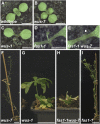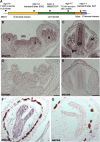MGOUN1 encodes an Arabidopsis type IB DNA topoisomerase required in stem cell regulation and to maintain developmentally regulated gene silencing
- PMID: 20228247
- PMCID: PMC2861470
- DOI: 10.1105/tpc.109.068296
MGOUN1 encodes an Arabidopsis type IB DNA topoisomerase required in stem cell regulation and to maintain developmentally regulated gene silencing
Abstract
Maintenance of stem cells in the Arabidopsis thaliana shoot meristem is regulated by signals from the underlying cells of the organizing center, provided through the transcription factor WUSCHEL (WUS). Here, we report the isolation of several independent mutants of MGOUN1 (MGO1) as genetic suppressors of ectopic WUS activity and enhancers of stem cell defects in hypomorphic wus alleles. mgo1 mutants have previously been reported to result in a delayed progression of meristem cells into differentiating organ primordia (Laufs et al., 1998). Genetic analyses indicate that MGO1 functions together with WUS in stem cell maintenance at all stages of shoot and floral meristems. Synergistic interactions of mgo1 with several chromatin mutants suggest that MGO1 affects gene expression together with chromatin remodeling pathways. In addition, the expression states of developmentally regulated genes are randomly switched in mgo1 in a mitotically inheritable way, indicating that MGO1 stabilizes epigenetic states against stochastically occurring changes. Positional cloning revealed that MGO1 encodes a putative type IB topoisomerase, which in animals and yeast has been shown to be required for regulation of DNA coiling during transcription and replication. The specific developmental defects in mgo1 mutants link topoisomerase IB function in Arabidopsis to stable propagation of developmentally regulated gene expression.
Figures







Similar articles
-
MGOUN1 and MGOUN2: two genes required for primordium initiation at the shoot apical and floral meristems in Arabidopsis thaliana.Development. 1998 Apr;125(7):1253-60. doi: 10.1242/dev.125.7.1253. Development. 1998. PMID: 9477323
-
ULTRAPETALA1 encodes a SAND domain putative transcriptional regulator that controls shoot and floral meristem activity in Arabidopsis.Development. 2005 Mar;132(5):897-911. doi: 10.1242/dev.01642. Epub 2005 Jan 26. Development. 2005. PMID: 15673576
-
OBE3 and WUS Interaction in Shoot Meristem Stem Cell Regulation.PLoS One. 2016 May 19;11(5):e0155657. doi: 10.1371/journal.pone.0155657. eCollection 2016. PLoS One. 2016. PMID: 27196372 Free PMC article.
-
Epigenetic Mechanisms Are Critical for the Regulation of WUSCHEL Expression in Floral Meristems.Plant Physiol. 2015 Aug;168(4):1189-96. doi: 10.1104/pp.15.00230. Epub 2015 Mar 31. Plant Physiol. 2015. PMID: 25829464 Free PMC article. Review.
-
WUSCHEL: a master regulator in plant growth signaling.Plant Cell Rep. 2020 Apr;39(4):431-444. doi: 10.1007/s00299-020-02511-5. Epub 2020 Jan 27. Plant Cell Rep. 2020. PMID: 31984435 Review.
Cited by
-
HAIRY MERISTEM with WUSCHEL confines CLAVATA3 expression to the outer apical meristem layers.Science. 2018 Aug 3;361(6401):502-506. doi: 10.1126/science.aar8638. Science. 2018. PMID: 30072538 Free PMC article.
-
A DNA2 Homolog Is Required for DNA Damage Repair, Cell Cycle Regulation, and Meristem Maintenance in Plants.Plant Physiol. 2016 May;171(1):318-33. doi: 10.1104/pp.16.00312. Epub 2016 Mar 7. Plant Physiol. 2016. PMID: 26951435 Free PMC article.
-
TOPOISOMERASE1α Acts through Two Distinct Mechanisms to Regulate Stele and Columella Stem Cell Maintenance.Plant Physiol. 2016 May;171(1):483-93. doi: 10.1104/pp.15.01754. Epub 2016 Mar 11. Plant Physiol. 2016. PMID: 26969721 Free PMC article.
-
Control of Arabidopsis shoot stem cell homeostasis by two antagonistic CLE peptide signalling pathways.Elife. 2021 Oct 13;10:e70934. doi: 10.7554/eLife.70934. Elife. 2021. PMID: 34643181 Free PMC article.
-
Plant and animal stem cells: similar yet different.Nat Rev Mol Cell Biol. 2014 May;15(5):301-12. doi: 10.1038/nrm3790. Nat Rev Mol Cell Biol. 2014. PMID: 24755933 Review.
References
Publication types
MeSH terms
Substances
LinkOut - more resources
Full Text Sources
Molecular Biology Databases

